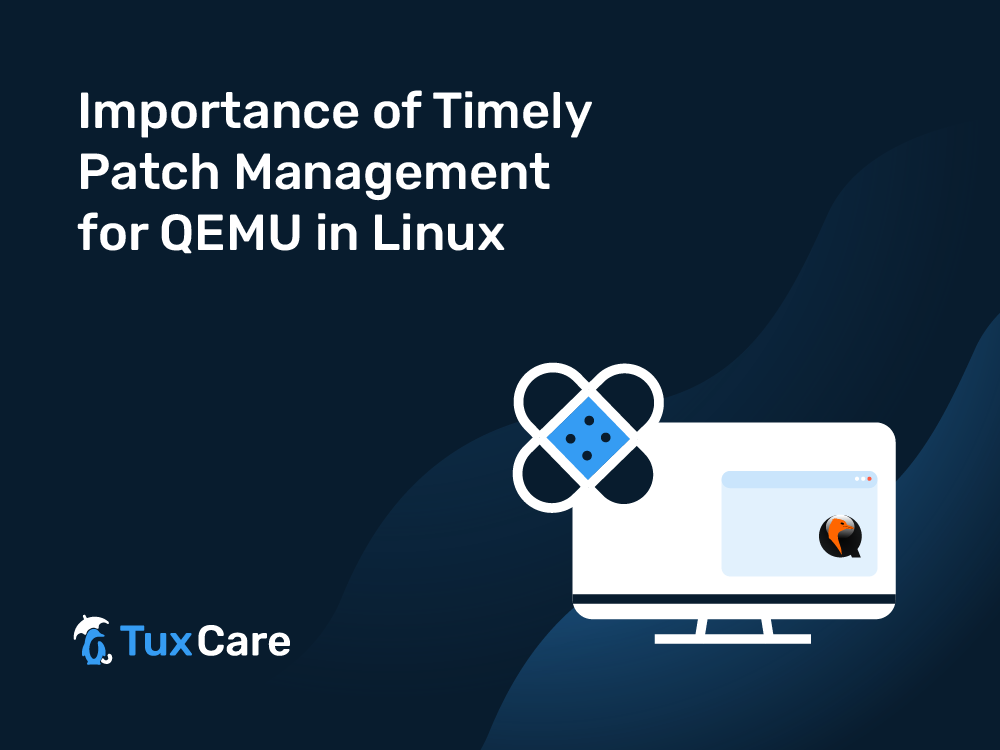The Importance of Timely Patch Management for QEMU in Linux
- Neglecting patch management for QEMU poses serious risks, including data breaches, privilege escalations, and compliance violations
- Timely deployment of security patches is crucial for mitigating vulnerabilities, safeguarding against potential exploits, and maintaining the security of Linux systems
- Automate security patching for QEMU-based virtualization systems with QEMUCare live patching solution
QEMU (Quick Emulator), a powerful open-source emulator, enables virtualization in Linux systems, offering flexibility and performance. However, with great power comes great responsibility, and one of the key responsibilities of Linux system administrators is to ensure timely patch management for QEMU. In this article, we’ll explore why patch management is crucial, the risks associated with delayed or neglected updates, and effective strategies for monitoring and deploying security patches in QEMU in Linux systems.
Understanding Security Patch Management
Security patch management is the systematic process of identifying, testing, and deploying patches or updates to systems. The main objective is to address known vulnerabilities in operating systems, software, and other components of an IT infrastructure.
Patch management for QEMU plays a crucial role in maintaining a secure and resilient IT environment. However, patching QEMU is a complicated task because of its unique nature. When QEMU undergoes patching, the entire virtualized workloads are affected, causing them to restart.
Importance of Timely Security Patch Management
Delaying patches or failing to address vulnerabilities promptly can have serious risks, including data breaches, privilege escalation, system downtime, and compliance violations. With a holistic approach to security patch management, administrators can safeguard systems from potential cyber attacks and ensure the overall integrity and confidentiality of sensitive data.
The benefits of timely security patch management for QEMU include:
Mitigating Vulnerabilities
Security patches are published to fix known vulnerabilities in the affected software. Delaying the application of these patches exposes systems to potential attacks, making timely updates crucial for maintaining a secure environment.
Meeting Compliance Requirements
Many industry regulations and standards mandate timely patch management. For this reason, it is essential for achieving compliance and ensuring that organizations meet industry standards and legal obligations.
Ensuring System Stability and Reliability
In the constantly evolving cyber threat landscape, malicious actors actively find new methods to exploit vulnerabilities in software. Regular and timely patching helps mitigate the risk of security breaches, protecting sensitive data and maintaining the stability and reliability of your Linux systems.
Monitoring QEMU Security Patches
Check Security Advisories
Stay informed about the latest QEMU security updates by subscribing to mailing lists and security advisories. Security advisories are often released when vulnerabilities are discovered, along with necessary updates for mitigating them.
Utilize CVE Databases
Common Vulnerabilities and Exposures (CVE) databases catalog known vulnerabilities. Regularly check these databases for QEMU-related entries to identify potential threats and the corresponding patches.
Deploying QEMU Security Patches Effectively
Here are some key practices to ensure timely and effective security patch management for QEMU in your Linux systems.
Prioritize Critical Patches
Not all patches hold the same risk level, so it is essential to implement a risk-based approach to patching. Identify the critical vulnerabilities based on their severity and patch them first to mitigate the potential impact.
Test Before Deploying
Although critical patches should be applied immediately, consider testing them in a non-production environment to ensure that the updates do not introduce compatibility issues or unforeseen problems.
Establish a Patching Schedule
Create a patching schedule that aligns with your organization’s operational needs. Regular, scheduled updates help maintain system security without disrupting critical business processes.
Utilize Live Patching
The conventional patching method often involves a reboot of virtualized workloads, causing inevitable disruptions. It is impractical in enterprise environments where any amount of downtime is not affordable. Additionally, rebooting systems can be a cumbersome process, especially when dealing with several virtual machines.
This is where live patching comes in – it’s not optional, it’s essential. Live patching allows you to apply updates without conducting an inconvenient reboot. TuxCare’s QEMUCare offers a live patching service to QEMU-based virtualization systems, ensuring your infrastructure is patched with zero downtime and zero end-user disruptions.
Automate Patch Deployment
To streamline the patch management for QEMU, use automated patching tools, like QEMUCare. QEMUCare automatically applies all security patches as soon as they are available. It ensures that patches are administered consistently across all relevant systems and lowers the possibility of human error.
Final Thoughts
By following these strategies, you can significantly reduce the risk of security vulnerabilities in QEMU and enhance the overall security posture of your Linux systems. Neglecting patch management for QEMU can have severe repercussions, jeopardizing your entire infrastructure security and stability and potentially causing significant financial and reputational damage. Remember, security is an ongoing process, not a one-time fix. Stay vigilant, patch promptly, and leverage the automated live patching of QEMUCare with peace of mind!
Speak to a TuxCare security expert to integrate QEMUCare into your QEMU-based virtualization systems.



 Documentation
Documentation Login
Login




